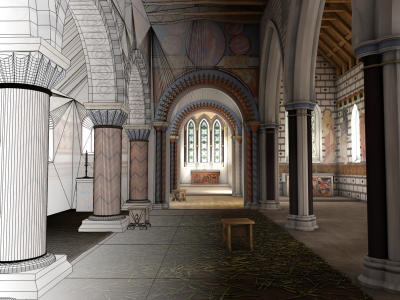
General Information
This one-day symposium explores the ways in which our understanding of the Medieval and Renaissance worlds can be enriched by innovative Digital Humanities projects. Our three speakers will show how interactive technologies like virtual mapping and digital reconstruction can help us and our students engage in creative and dynamic ways with the religious buildings and urban environments of the past.
Schedule of Events
10:00 a.m. - 11:00 a.m.
Jim Knowles (North Carolina State): “Reconstructing the Lost Mendicant Houses of Medieval Oxford"
Abstract
Bio
Recording (.mp4 file)
11:00 a.m. - 11:30 a.m.

Q&A session
11:30 a.m. - 1:00 p.m.
Lunch break
1:00 p.m. - 2:00 p.m.
Anthony Masinton (Independent Scholar): “How to Build a Time Machine: 3d Modeling and Video Games as Portals into Medieval and Early Modern Minds”
Abstract
Bio
Recording (.mp4 file)
2:00 p.m. - 2:30 p.m.
Q&A session
2:30 p.m. - 4:00 p.m.
Afternoon break
4:00 p.m. - 5:00 p.m.
CMRS Lecture Series entry #2 – Symposium Keynote
Janelle Jenstad (University of Victoria): “Walking through Time: Textual Archaeology and the Map of Early Modern London”
Abstract
Bio
5:00 p.m. - 5:30 p.m.
Q&A session
If you require an accommodation such as live captioning or interpretation to participate in this event, please contact cmrs@osu.edu. Requests made by about 10 days before the event will generally allow us to provide seamless access, but the university will make every effort to meet requests made after this date.
Information about our Speakers
Jim Knowles (North Carolina State): “Reconstructing the Lost Mendicant Houses of Medieval Oxford"
The Oxford Friars Project (2010-2014) attempted to digitally reconstruct the architectural history of the lost Franciscan and Dominican foundations of medieval Oxford. Using data from archaeological surveys of the two sites carried out in the 1960s and 1970s, the project built low-budget conceptual models of the two friaries and created a short animated film which placed those models in the context of English anti-fraternal literature – including Chaucer, Langland, and Wycliffite materials.

But because the creation of the project overlapped with the emergence of the field of Digital Humanities – with its data-driven and empirical methodologies that were often alien to literary studies – the reception of the Oxford Friars Project among scholars in medieval studies was found to be interestingly bifurcated. This paper will provide an overview of the project and its reception, exploring how the perceived split between “digital” and “traditional” methods has potential ramifications for the future of teaching and research at the intersections of literary study, architectural history, and archaeology.
Anthony Masinton (Independent Scholar): “How to Build a Time Machine: 3d Modeling and Video Games as Portals into Medieval and Early Modern Minds”
Digital reconstruction of medieval and early modern spaces using 3d modeling and video game technologies offers unexpected and valuable glimpses into not only the material reality of the past, but also to its lived experience. The process of reconstruction itself is a powerful research method in its own right because it draws together archaeological, historical, textual, and immaterial evidence into a unified framework for envisioning and re-envisioning the past. We will begin in the late 11th century crypt of Worcester Cathedral, with St Wulfstan, pondering the play of light and dark

in the crypt's forest of columns. We will then move through seven centuries of lay devotion as it reshapes a parish church. We will walk with Erasmus through Canterbury Cathedral on the eve of the Reformation before whitewashing the mural paintings in Holy Trinity Chapel, in Stratford-upon-Avon, alongside Shakespeare's father. Finally, we will act as the architects of a great cathedral using a playful, interactive approach designed to encourage present-day scholars of the medieval past to engage creatively with their research.
Janelle Jenstad (University of Victoria): “Walking through Time: Textual Archaeology and the Map of Early Modern London”
MoEML’s current project, a versioned digital edition of John Stow’s Survey of London, is a textual walk through time. Stow’s Survey, inspired by The Perambulation of Kent, beats the bounds of each ward, treads each street and alley in words, and digs down through layers of history and platial change. In describing places across time, this text offers extraordinary topographical, toponymical, and prosopographical riches. While Stow’s 1603 Survey is often treated as a source of historical information about the city, the posthumous editions prepared by his literary successors are given little attention. The 1633 Survey continues the history of London, tracks changes to buildings and organizations, and adds layers of commentary to a text already temporally and historically layered. Janelle Jenstad will take MoEML’s work on the Survey as a starting point for a discussion of the ways in which digital editing, the digital geohumanities, and linked open data are revitalizing historical and literary understandings of the early modern and providing new teaching and research opportunities.
